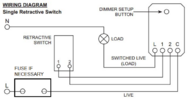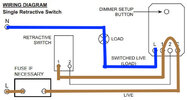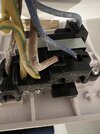I've searched on this forum a few times and there are similar topics but I can't seem to find something for this particular issue.
I'm replacing a normal fused spur light switch with a fused spur toggle dimmer switch. The dimmer unit is separate to the switch and the fuse and I'm struggling to work out how to wire it which I hope someone can help me with. I'm a beginner to wiring/electrics and I think what I'm missing is jumping from the dimmer unit to the switch?
Thank you in advance.
I've included pictures of the back of each of the modules/units - The dimmer unit is an Enkin unit as below, the back of the toggle switch, and the fuse unit itself is below.



I'm replacing a normal fused spur light switch with a fused spur toggle dimmer switch. The dimmer unit is separate to the switch and the fuse and I'm struggling to work out how to wire it which I hope someone can help me with. I'm a beginner to wiring/electrics and I think what I'm missing is jumping from the dimmer unit to the switch?
Thank you in advance.
I've included pictures of the back of each of the modules/units - The dimmer unit is an Enkin unit as below, the back of the toggle switch, and the fuse unit itself is below.





